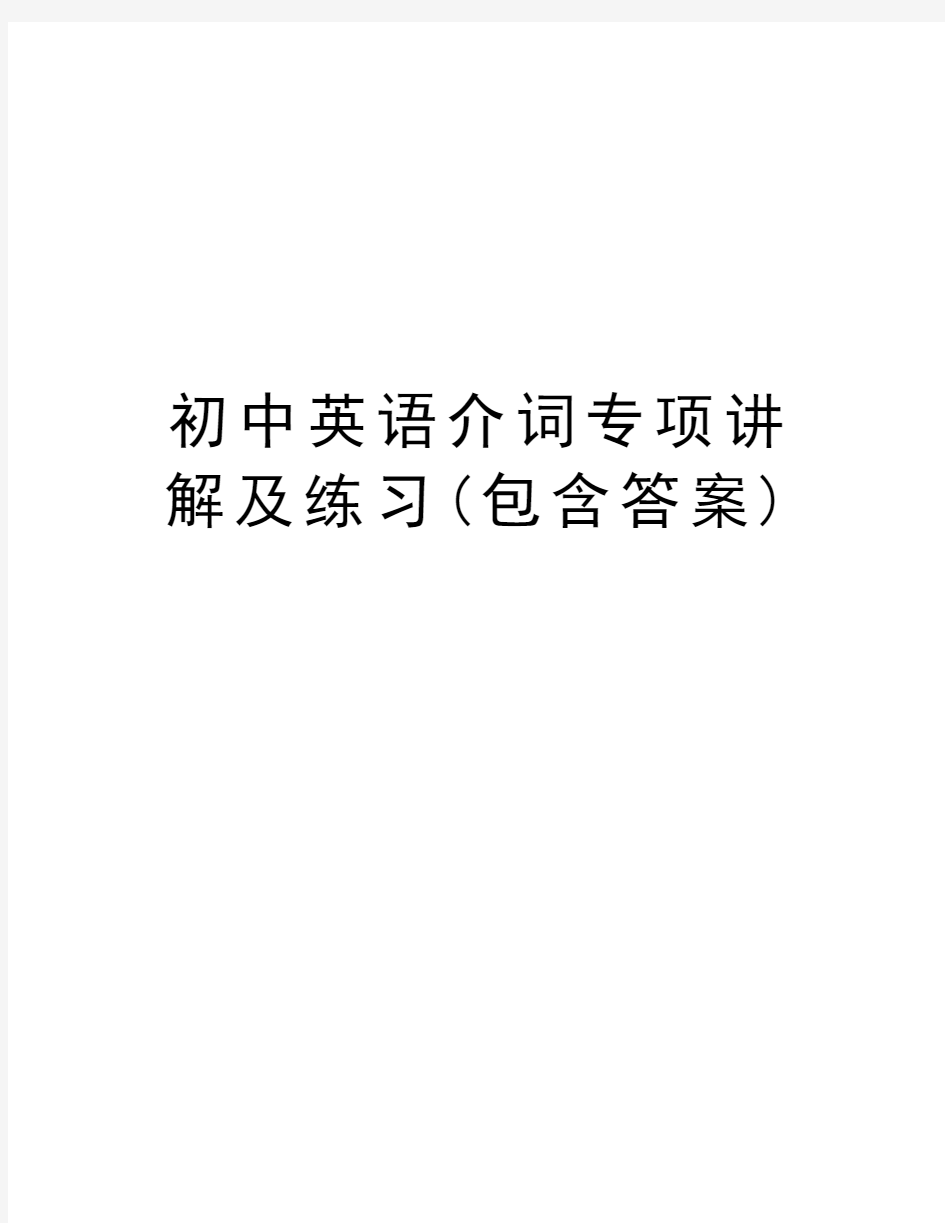初中英语介词专项讲解及练习(包含答案)资料讲解

- 1、下载文档前请自行甄别文档内容的完整性,平台不提供额外的编辑、内容补充、找答案等附加服务。
- 2、"仅部分预览"的文档,不可在线预览部分如存在完整性等问题,可反馈申请退款(可完整预览的文档不适用该条件!)。
- 3、如文档侵犯您的权益,请联系客服反馈,我们会尽快为您处理(人工客服工作时间:9:00-18:30)。
初中英语介词专项讲解及练习(包含答案)
一.介词的含义
介词是一种虚词,用来表示名词或相当于名词的其它词语与句中其它词的关
系,不能单独使用。介词可以与名词或相当于名词的其它词构成介词短语。二.表示时间的介词
at (表示钟点): at 6:30 固定搭配: at noon ; at night ; at present / at the moment
in (表示年代/月份/季节): in July; in 2006; in September,1998 ;
in spring
固定搭配: in the morning / in the afternoon / in the evening
on (表示具体日期: 某月某日/星期几): on Monday ; on Sunday morning ; on December 17
before在 --- 之前after 在--之后
by在--之前(时间);到--为止until / till : 直到 --(时间)
since自从 -- 以来for(接一段时间)
during 在 -- 期间from 从--时起
in + 一段时间: --以后(用于将来时)within --之内
after+ 一段时间:--以后(用于过去时) beyond --之外
三.表示场所,方向的介词
at 在某处(小地方)(at the cinema; at school; at home; at the railway station)
in 在某处(大地方)(in China; in Beijing);在--里面(in the classroom; in the water)
on 在--上面(紧贴着其表面): (on the table; on one’s face)
near 在---附近 beside:在--旁边by 在--旁边between在--和--之间among在--(3者或更多的人或物)当中
in front of 在--的前面behind 在--的后面 beside: 在—旁边
into 进入--里out of 从--中出来 near / nest to 靠近
across穿过(沿着表面)through穿过(从中间)along 沿着
from -- to -- 从--到-- around 在--周围
over 在--的正上方under在--的正下面 / above 在--斜上
方below 在--斜下方
四.其他介词
in 用(某种语言),穿着(某种颜色的衣服)about大约;关于
from 来自 ---
as像--(接句子);正如--; like 像--(接单词)
with和--起;用-- without 没有-- by通过(某种方式或手段);乘坐by bus(train /plane /ship /bike)
on foot
五.重要介词辨析
(1)on, over与above
On 在……上面与物体表面有接触面
Over 在……上方垂直正上方,表示“跨越,覆盖”
Above在……上方“在……(偏)上方”,表示两者不接触
例如:
There is a bag on the desk.
The lamp is over the table.
The heaven is above us.(苍天在上。)
(2)in, on 与to
in 用于主语被包含于某一范围之内。
on 用于表示两地互相接壤。
to 用于主语在某一范围之外。
例如:
Beijing lies in the north of China.
北京位于中国的北部。
Rusia is on the north of China.
俄罗斯在中国的北面。
Japan is to the east of China.
日本在中国的东面。
(3)across, over, through 与past
across “穿过”强调从物体表面的这一边到另一边
over “越过”强调从人或事物的上方经过,越过
through “穿过,通过”强调从物体内部穿过;从长形物的一头到另一头。
past “经过”只从物体旁边经过
例如:
If you see the green light, you can walk across the street.
The train run through the tunnel(隧道).
I can jump over the fence(围墙).
We walked past the hospital.
(4) except, except for, besides与but
except “除……以外”表示同类事物之间的关系
except for “除……以外”,“如果不是”,“若非”表示对局部的否定,不表示同类
事物之间的关系besides “除……以外”,“还有……”所指事物包括在叙述范围之内
but “除……以外”多与nobody, none, no one, nothing, anything, everyone, all,
who连用
例如:
We all went swimming except Ann.
Besides Ann, we all went swimming.
Your composition is good except for some spelling mistakes.
No one but Peter went there.
(5) in front of 与in the front of “在……前面”
in front of 指一个物体在另一个物体的前方
in the front of 指一个物体包含在另一个物体内部的前方
There is a big tree in front of the classroom.
There is a desk in the front of the classroom.
(6) since 与 for
